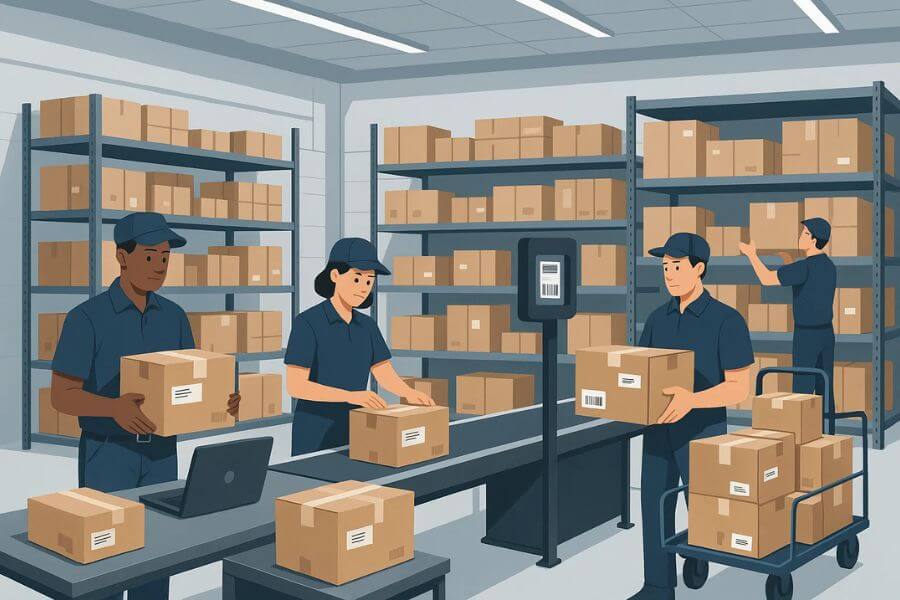In a competitive ecommerce landscape, businesses are constantly seeking ways to reduce operational costs, and shipping is one of the most significant expenses. However, while it’s important to cut costs, it’s equally vital to maintain a positive customer experience. Customers expect fast, affordable shipping, and any compromise in that area can affect satisfaction and loyalty.
The good news is that it’s entirely possible to reduce shipping costs without sacrificing customer experience. Here are 10 actionable strategies that can help your business save on shipping while keeping your customers happy.
1. Optimize your packaging
Packaging plays a crucial role in shipping costs, and the way you package your products can significantly affect both the price you pay for shipping and your environmental impact. By optimizing your packaging, you can reduce both the size and weight of your shipments, leading to lower costs.
How to optimize packaging:
- Use the right size box: Avoid over-packaging products in unnecessarily large boxes. Choose boxes that fit the product well to reduce unused space, which can add to the shipping cost.
- Lightweight materials: Use lightweight, but durable packaging materials to reduce weight. For example, consider switching from plastic to biodegradable paper for padding.
- Use custom packaging: Investing in packaging tailored to your products can help avoid wasted space, which can contribute to dimensional weight pricing (where the charge is based on volume rather than weight).
By making these adjustments, you can save on shipping fees while also offering your customers a sustainable, professional experience.
2. Leverage shipping software for rate comparison
One of the easiest ways to cut shipping costs is to compare rates. Shipping software allows businesses to compare the prices of multiple carriers, helping you find the most cost-effective option for each shipment.
How to use shipping software:
- Multi-carrier comparison: Platforms like ShipStation or Shippo allow you to compare prices from major carriers such as UPS, FedEx, DHL, and USPS.
- Rate shopping automation: Many shipping software solutions allow you to automate rate shopping, which helps you select the best price based on delivery speed, destination, and package size.
- Negotiate discounts: Shipping software can provide insight into how much you could save by negotiating with carriers or by purchasing shipping in bulk.
By using shipping software, you’ll be able to take advantage of the best deals for each shipment, which can help you pass on savings to your customers without compromising delivery speed.
3. Implement free shipping with minimum order value
While free shipping is a key factor in customer satisfaction, it can quickly eat into profit margins. To strike the balance between reducing shipping costs and enhancing customer satisfaction, consider offering free shipping on orders above a certain threshold. This method encourages larger purchases while keeping shipping costs manageable.
How to implement it effectively:
- Set a reasonable threshold: Determine a minimum order value that covers the cost of shipping without eating into your profits. For example, you might offer free shipping on orders over $50 or $100.
- Track customer behavior: Use analytics to monitor customer behavior and adjust the minimum order value accordingly. This will help you ensure that your threshold is enticing enough for customers to spend more.
By providing free shipping on larger orders, you can both encourage sales and manage shipping costs, all while keeping customers happy.
4. Use regional warehousing to speed up delivery
Using regional warehouses to store products closer to your customers can significantly reduce both shipping times and costs. Instead of relying on a central warehouse to fulfill orders for customers across the country, consider spreading inventory across strategically located warehouses.
How to implement regional warehousing:
- Partner with a 3PL: Third-party logistics providers (3PLs) can help you establish regional warehouses in key areas, reducing the time it takes for products to reach customers.
- Ship from the closest warehouse: Ensure that orders are shipped from the nearest warehouse to minimize delivery distances and reduce shipping rates.
With this approach, your customers will benefit from faster delivery times, and you can save on shipping costs by minimizing long-distance shipping charges.
5. Choose the right shipping carrier for the job
Not all shipping carriers are equal, and selecting the right one can make a huge difference in the cost and delivery time of your shipments. Different carriers offer varying rates, services, and delivery options, so it’s essential to choose the one that suits your business needs.
Carrier selection tips:
- Evaluate cost and service: Look beyond just the cheapest option. A carrier that offers lower rates but delivers late or damages packages may hurt your customer satisfaction.
- Consider shipping zones: Some carriers may offer better rates for specific regions or types of delivery.
- Offer multiple shipping options: Allow customers to choose between standard, expedited, and next-day delivery, based on their preferences and urgency.
By choosing the right carrier for each shipment, you can reduce costs without negatively affecting the customer experience.
6. Offer a variety of shipping options
Customers are looking for flexibility when it comes to shipping. While free shipping is always a winner, offering a range of shipping options allows customers to choose what works best for their needs. For instance, some customers might prefer to pay a little extra for faster delivery, while others may opt for slower but more affordable options.
Ways to offer flexibility:
- Standard, expedited, and overnight options: Let customers decide if they want the most economical shipping or need their order sooner.
- Local pickup options: If applicable, offer customers the choice to pick up their orders at a nearby retail location or fulfillment center, saving both them and you on shipping costs.
- Subscription shipping options: For repeat customers, consider offering subscription models that can lower shipping costs on each purchase.
By giving your customers more control over their shipping options, you cater to their needs and reduce the chances of abandoned carts due to high shipping fees.
7. Consolidate shipments
Consolidating shipments can help you save on shipping costs, especially for customers who place multiple orders in a short period. Instead of shipping each item separately, you can bundle them together to save on postage.
How to consolidate shipments:
- Automatic order grouping: Use your ecommerce platform to automatically combine orders from the same customer, if possible, into one shipment.
- Ship once a week: If your business receives multiple orders for the same customer over several days, consider sending all the items in one consolidated shipment at the end of the week.
Consolidating shipments reduces the number of parcels you send out and can result in lower shipping costs without affecting the overall customer experience.
8. Negotiate better rates with carriers
Shipping costs can often be negotiated with carriers, especially if you have a high volume of shipments. Larger businesses or those with regular, consistent shipping needs are often eligible for discounts.
How to negotiate shipping rates:
- Assess your volume: Carriers are more likely to offer discounts if you’re shipping large volumes of packages. Track your shipping volumes to determine whether you can qualify for volume-based discounts.
- Leverage long-term relationships: Establish long-term contracts with carriers to negotiate better rates.
- Consider a freight forwarder: For larger shipments, freight forwarders can help consolidate shipments and offer competitive rates based on volume.
Negotiating better rates with carriers allows you to reduce costs, and you can pass those savings on to your customers, enhancing their experience.
9. Use dimensional weight pricing to your advantage
Dimensional weight pricing is used by many carriers to calculate shipping charges based on package size rather than weight. Understanding how this pricing model works can help you minimize charges.
How to minimize dimensional weight costs:
- Use smaller packaging: If your product is lightweight but large, use the smallest packaging that will protect the item. This reduces the dimensional weight and shipping cost.
- Consider flat-rate shipping boxes: Some carriers offer flat-rate shipping boxes, which can save you money on large but lightweight shipments.
Understanding dimensional weight pricing and how to reduce it can help you optimize your shipping costs without compromising on customer satisfaction.
10. Improve inventory management
Effective inventory management can help you avoid shipping delays and excess stock that may increase storage costs. Having the right products in the right place at the right time means less back-and-forth between warehouses, which reduces both lead times and shipping expenses.
Ways to improve inventory management:
- Use inventory management software: Automate your inventory to ensure that you have the right stock levels at the right locations.
- Analyze demand patterns: Use data to forecast demand accurately, so you don’t overstock or run out of popular items.
- Reduce backorders: By staying on top of inventory levels, you can reduce the chances of backorders, which can lead to multiple shipments and added costs.
By improving inventory management, you streamline your fulfillment processes and reduce shipping costs while ensuring a smooth customer experience.
Conclusion
Reducing shipping costs without negatively impacting the customer experience is a delicate balance, but it’s definitely achievable. By optimizing packaging, using shipping software, leveraging regional warehouses, and offering flexible shipping options, you can reduce costs while still keeping your customers satisfied. In the end, it’s all about being smart with your approach, using technology to your advantage, and constantly reassessing your strategies to ensure that you’re providing the best service at the most affordable price.
By implementing these 10 strategies, you’ll be able to cut shipping costs while enhancing customer satisfaction, making it a win-win for both your business and your customers.





